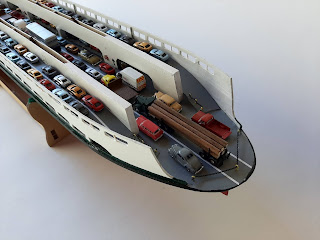My part was small, but my pleasure is great. As with previous collaborations presented in this blog my role amounted to 1%, generously 2%, but like that same part of the population my wealth was great. At first, I did not believe my friend Tom, who is a superb model ship builder, when he said he was about to attempt a ferry vessel but this time from scratch: no plans, no kit, no directions, no pre-cuts, no dimensions, only photos and videos of the Washington State Ferry M.V. HYAK. Without question I spent many times the time over discussions about scaling the hull than in the actual rough shaping of it. Subsequently we had many a pleasant chat over coffee at our COVID café in my front patio, hashing over detail after detail. More is yet to come as additional decks are constructed. Nonetheless, let's get up-to-date on this monster miniature project and let Mr. Tom Schell speak for himself:
BACKGROUND
The M.V. HYAK was a Super-class ferry that was operated by the Washington State Ferries; built in 1966 in San Diego and finally retired in 2019. “Hyak” is a Chinook Indian term meaning “speedy”. The normal routes were the Seattle-Bremerton or the Anacortes-San Juan Islands run. At times, other routes were substituted namely the Edmonds-Kingston. While her sister ferries were up-graded (usually interior) the HYAK never was so the interior was the original and in her later days it had started to show. Top speed was around 17 knots but I suspect the boat was worked at around 15 knots which is approx. 17 mph. The Edmonds to Kingston leg took 30 minutes.
Just a few tidbits from her history: on her maiden run in 1967 she almost rammed pier 52 in Seattle due to an engine failure, in 1986 she ran aground outside Anacortes due to a navigational error, and in 2013 she stove and sank a 27 foot sailboat between Orcas and Shaw islands. Being a native of the Seattle area and having vacationed there many times since, I was able to take a “poor man’s cruise” many times on both the Edmonds and Anacortes routes. For approx. $7.00 a passenger could purchase a round trip “sea excursion” from Edmonds over to Kingston and back. Ah, fresh air, the bounding seas, and great fun for me!
I decided on HYAK more for memorabilia purposes than anything else. But my memories were not just of the exterior of the boat but also the interiors (there are five decks). To show these, I decided to build the model such that these different decks would be visible; hence each deck is removable in order to see the one below.
There were no “model kits” available so I researched what original plans still existed (only one deck was found on Google) and photos that were available on line. Plus, there is a “tour” video someone made of the HYAK interiors just before it was decommissioned. I then had to determine on how much display space I had available and this set the model length at 2 feet. Just by coincidence (it could be referred by some as blind luck) this, in turn, set the scale at about 1/150 which just happens to be the scale of “N” gauge railroad models and supporting scenery.
Plans were drawn (old fashioned pencil to paper) and work commenced. I don’t think I am too far off on the model, but it certainly is not exact, yet still “close enough for government work”. The material used was bass wood. To shape the hull I enlisted the aid of Kurt Meyers who is versed in woodworking and has tools, saws, skill, etc. and he rough cut the hull which saved a substantial amount of work for me. Side bulkheads were fashioned from two 1/32” thick bass wood sheets using clear acrylic for the windows (sandwiched between two sheets).
“N” gauge railroad scenery was the source for the coke machines, sinks, human figures, toilets, etc. The paint used was acrylic, and here I ran into a problem. Acrylic is water based, and water warps wood. Once again Kurt came to the rescue; all boards are first coated with shellac which prevents warpage when the final acrylic paint is applied. To purposely bend the wood where needed it is first soaked in water and then bent with the aid of a “soldering iron” device. Note: there is a special tool model makers use to do this using a round heated cylinder shape instead of a normal sharp point iron. The automobiles were in part “N” gauge scenery that were available (expensive) and smaller cars (cheap) that were originally manufactured in China as cake decorations.
The logs on the logging truck were made just by staining normal doweling. The stain soaks in a little and it looks like bark. Glue was cyanoacrylate (fast drying and structural) or plain old Elmer’s Glue-All (used where you want to move the parts around a little bit to get the right position before the glue sets up). Both dry relatively clear.
Notes: 1) The empty areas of the passenger deck (second level) really had movable chairs positioned there. They put these in so that they could be used or moved aside for dances (sometimes square dancing) during the passage. During my trips on the HYAK I never saw any dancing and, as such, the chairs were always just scattered about or pushed aside. I have not shown these as it neither adds nor subtracts from the impression. 2) I have shown the exhaust stacks thru the inner decks as cylindrical. On the actual boat they are not visible to the passenger and, therefore, they have to be contained inside the office space which is a locked room. They well may be some other shape.









